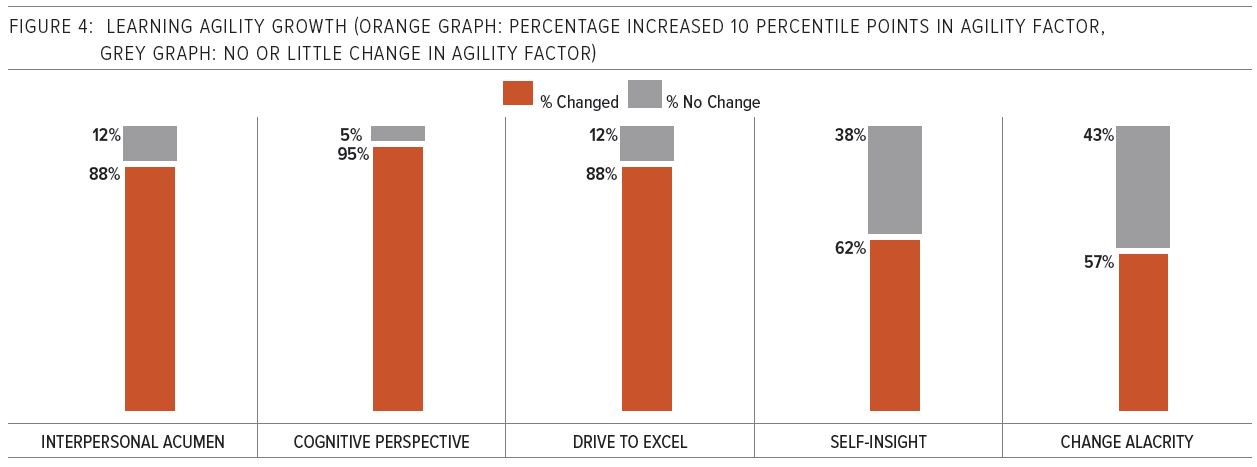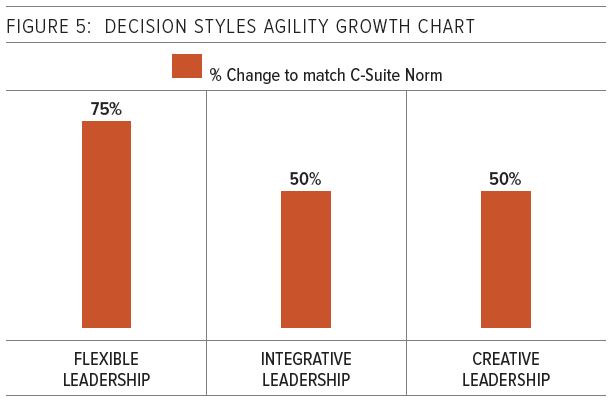How to Identify and Grow High Potentials: A CEO's Perspective with Proven Results
By Marilyn Buckner and Mike Marberry
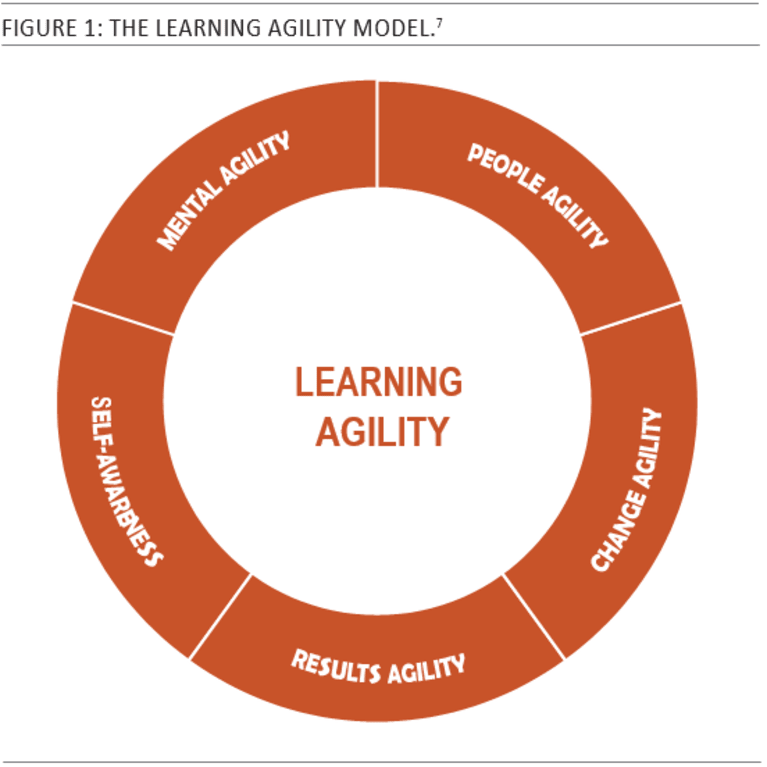 Learning agility is defined as “the ability and willingness to learn quickly, and then apply those lessons to perform well in new and challenging leadership situations.”5 A basic model of learning agility includes the core factors of Results Agility, People Agility, Mental Agility, Change Agility, and Self-Awareness.6
Learning agility is defined as “the ability and willingness to learn quickly, and then apply those lessons to perform well in new and challenging leadership situations.”5 A basic model of learning agility includes the core factors of Results Agility, People Agility, Mental Agility, Change Agility, and Self-Awareness.6
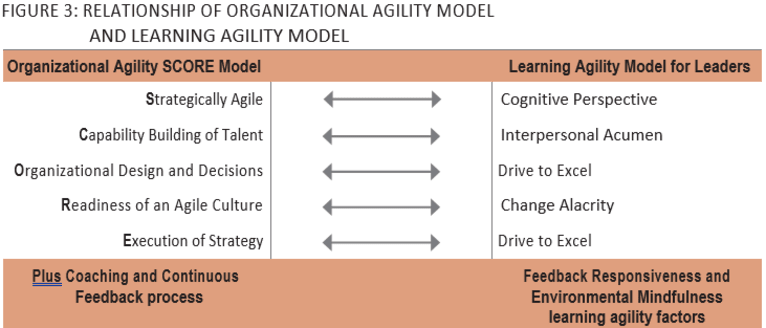
Results of the Program
Pre- and Post-Learning Agility scores from 2013 to 2016
References
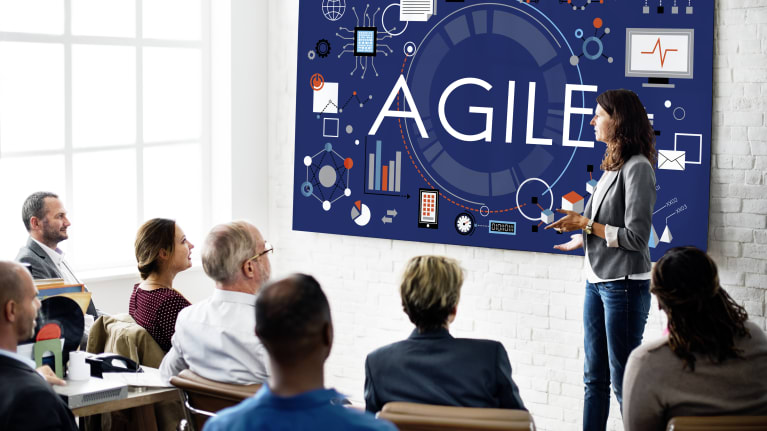
We live in a dynamic, constantly changing world where organizational agility is critical. It requires that businesses be adaptable and agile. It requires that systems and processes be nimble. It requires that leaders be learning agile to support the organizational design and culture. With this insight, we built organizational agility and learning agility into a leading-edge program designed for evaluating, selecting, and developing high potential senior leaders at J. M. Huber Corporation.
What type of Development Experiences Work to Grow Learning Agility?
The challenge for companies is discovering what types of programs accelerate executive development and build learning agility.
Results and outcomes, measured at the end of the multiyear initiative, were impressive. We identified two validated learning agility assessments that provided proof of high potential development growth. As an added benefit, the Human Resources function could leverage many of the assessment tools and program content for other purposes, such as high potential selection, talent review, leadership coaching, strengthening culture, and external selection. This article provides insight into the CEO’s vision (See Spotlight Perspective in this article) to initiate this first comprehensive program to grow C-Suite global leaders and how it was executed in partnership with HR leadership. We will describe learning agility and the components of the unique curriculum to build advanced leadership skills, the in-depth coaching and feedback program to prevent derailment, and the link to organizational agility and culture that reinforces the components in a systems approach.
What is the best way to identify high-potentials and measure their progress?
Leading Edge Methods to Identifying High-Potentials
Because many companies use learning agility as an identifier of high potential, we decided to focus on instruments to aid in the process. Researchers have discovered that more than half of the top talent companies use learning agility to identify high-potentials and to select senior executives.1 The popularity of the concept has increased significantly throughout the business world since it helps identify future potential. A recent survey of the top talent-focused companies found that learning agility was the most frequently used criterion (62%) for measuring leadership potential.2 We wanted to explore how to use the construct of learning agility in assessments for selection and for leadership training and development.
The Two Validated Growth Assessments of Learning Agility used for Selection and Development
To determine whether we had the right talent for future C-Level roles, we included two assessments. One was a validated assessment of learning agility to predict those who are best able and willing to take on new jobs.3 A second measure of leadership, decision styles, was used to predict those styles of highly successful leaders related to learning agility.4
What is Learning Agility?
 Learning agility is defined as “the ability and willingness to learn quickly, and then apply those lessons to perform well in new and challenging leadership situations.”5 A basic model of learning agility includes the core factors of Results Agility, People Agility, Mental Agility, Change Agility, and Self-Awareness.6
Learning agility is defined as “the ability and willingness to learn quickly, and then apply those lessons to perform well in new and challenging leadership situations.”5 A basic model of learning agility includes the core factors of Results Agility, People Agility, Mental Agility, Change Agility, and Self-Awareness.6
The learning agility foundational key facets are:
- Results Agility: Cognitive Perspective - Critical and strategic thinking.
- People Agility: Interpersonal Acumen - Understanding of others and having the ability to work with them effectively.
- Change Agility: Change Alacrity - Possessing an insatiable appetite for change and innovation.
- Results Agility:Drive to Excel - Being highly motivated to get things done.
- Self-Awareness: Self-Insight - Understanding one’s self and one’s own strengths and weaknesses.
Assessments that predict high potential status
We used a learning agility model and assessment because it provides insight into leadership agility and links very well to the newly created and customized Huber leadership competencies. The Huber competency model includes detailed behavioral indicators and interview questions, and has become a valuable tool to Human Resources for various applications such as selection, promotion, on-boarding, and talent review.
The learning agility tool we used has been recognized by leadership and human resource experts. Dr. Dave Ulrich, the Rensis Likert Professor of Business, University of Michigan, has said this about the TALENTx7 Learning Agility assessment: “With exceptional research and broad experience, they have created incredible and relevant insights on upgrading talent. Their TALENTx7 tool helps companies transform talent aspirations into actions.”8
The learning agility and decision styles assessments, combined with three well-known and validated Hogan Leadership inventories (Hogan Development Survey, Hogan Personality Inventory and Hogan Motives, Values, Preferences Inventory) provided a robust evaluation of readiness for the executive development program. We developed a visual dashboard of these metrics to organize, display, and link the measures of the various skills. Using the learning agility model as criteria for goals and success helped ensure that the return on investment will yield continued positive results for Huber.
What are the benefits of a multiyear process rather than a one-time program?
Creating an Organizational Agility Model to Design a Powerful and Engaging Curriculum
We created a unique organizational agility model entitled SCORE© that included key components of a highly functioning organization to develop the curriculum. This organizational agility and readiness cultural model was utilized as a way of measuring strategic readiness. Examples of some of the content mapped to the SCORE model is shown below. The organizational agility model was also used to ensure the various kinds of learning agility content be utilized as depicted in the chart (Figure 2) and to ensure growth (Figure 3).
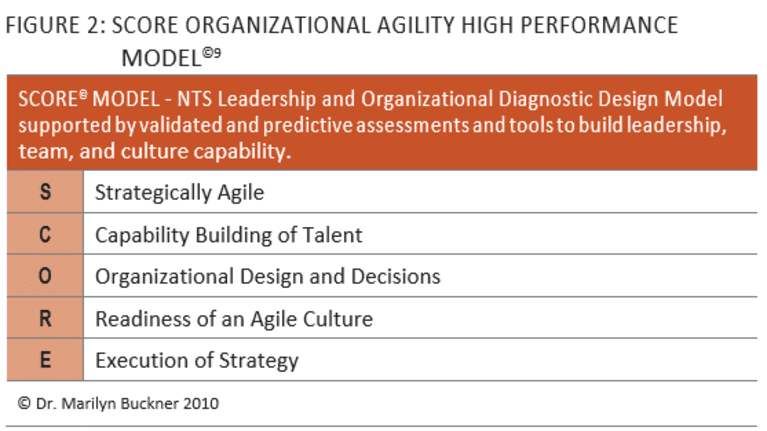

- Strategically Agile: Leading edge strategic tools such as Blue Ocean Strategy (for creating new market space) were used to identify potential new innovation products for the companies as well as the traditional Competitive Strategy methods were taught; innovative Design Thinking methods were learned using a change simulation.
- Capability Building of Talent: General manager high performance simulation with participants taking on a different functional leader role, cross functional teams to build relationships across companies.
- Organizational Design and Decisions: Scenario planning using real product lines and custom cases.
- Readiness of an Agile Culture: Comprehensive culture survey that predicts financial performance. Used as a multiyear growth metric with cascading action plans on organizational agility areas to reinforce culture to support strategy.
- Execution of Strategy: Strategic execution simulation and custom new product strategic execution case and tools.

Leading Edge Future-Focused and Agile Content and Faculty
We identified experts from a variety of academic and consulting areas to utilize high impact content and tools to accelerate leadership agility. Each of the week-long executive education programs and development coaching programs were designed to engage senior leaders.
Relationship of Organizational Agility Model and Learning Agility
Additionally, we found it helpful to map the organizational agility framework with the learning agility factors to ensure growth in related areas to maintain momentum for development and to prevent career stalls.
What is the unique focus of the coaching and feedback approach?
Avoiding Leadership Failure
Researchers have estimated that 50% of managers fail for a variety of reasons.10 Regardless of the reasons given, executive failure has a high cost. One author estimated that the price of a derailed executive can be as high as $2.7 million.11 Furthermore, it can be very expensive to go outside of the organization to hire people for key high-level jobs. We realized that if the J. M. Huber Company grew talent from inside and reinforced the company culture and practices, large benefits would result.
Identifying Derailment Factors and Lessening Their Impact on Leaders
There are many types of derailment factors. We focused on two areas of growing agility and self-awareness to prevent derailment. Earlier researchers from the Center of Creative Leadership in the field of learning agility discovered that the derailment of leaders was due to their inability or lack of willingness to change and adapt their behaviors.12
We also turned to the Hogan Development (Derailer) Survey, which identifies factors that predict derailment and potential career stalls. All participants were provided with feedback from certified coaches on all three Hogan leadership reports and decision styles. This was done on multiple occasions to gain insight through continuous feedback and to heighten awareness of their traits and derailers. Lack of self-awareness is one of the major derailment factors.13
Results of the Program
- HR Orchestrator: The CHRO played a key role in identifying and coaching leaders throughout the program to implement the tools and find developmental roles for those who needed the next growth opportunity.
- Agility Focused: Agility concepts were built into the design of the program to grow leadership and organizational agility.
- Metrics: Outcomes were measured behaviorally and quantitatively through promotions and performance evaluations.
- Multiple Assessments: Rather than relying on one measure, we used a comprehensive suite of leading edge, highly researched assessments that drove readiness, selection, coaching areas of focus, competencies and outcomes.
Multiple Results
Results and the outcomes measured at the end of the multiyear initiative were impressive and justified the effort and investment. Other indicators of success were also positive. Several participants received significant promotions during the process. One leader accelerated to a president position and others took on additional responsibilities. Moreover, the number of participants rated as “ready now” increased during the talent management process. Consequently, each Huber division was strengthened by the benefits these leaders received from the program and the overall organizational culture became more unified and directional.
Overall positive results of the program include:
- Pre-/post-learning agility scores with increases showing significant growth to identify those most ready to be promoted or given developmental assignments.
- Pre-/post-decision styles growth in flexibility and integrative leadership and creative integrative thinking strategic styles, which are the key indicators for continued leadership success.
- Talent data: Promotions, expanded job responsibilities, and accelerated “ready now” status was obtained for future opportunities.
- Hands on observations by presidents, board members, and CEOs of growth and complex skill sets for each participant.
- Cultural survey of the entire organization showing increases and changes in culture components between years.
- High ratings by participants, indicating usefulness and engagement of content.
- Other major program implementations, such as a global customer value program and innovation processes.
Key Agility Leadership Outcomes: Pre- and Post-Measures
Near the end of the program, a group of leaders most ready for promotions were measured again on learning agility and decision styles. Results showed a significant overall increase in learning agility scores in approximately three years.
The five core factors of learning agility were examined. This group of 21 leaders had a very high and significant increase in their Results Agility/Cognitive Perspective (88%), People Agility/Interpersonal Acumen (95%), Drive to Excel (88%), Change Alacrity (57%) and the Self-Insight (62%) by a minimum of 10 percentile points in three years. A 10-percentile point change was used as the change metric, but most had double or more increases in scores.
Pre- and Post-Learning Agility scores from 2013 to 2016
Decision Styles and Agility Growth
A second validated and predictive assessment of decision styles, offered a different index of agility. Research showed that successful leaders increase their use of flexible and integrative leadership and thinking skills to very high levels over their career as compared to less successful peers.14
The Decision StyleView assessment measures how people handle decisions when working with others and when thinking through problems. Among other things, it shows how easily an individual can handle changing circumstances and ambiguity, as well as the extent that a person tends to think strategically versus more tactically.
Participants were assessed in the beginning of the program and at the end. There was a significant shift in their leadership inclusive flexible styles and their participative integrative styles that support creative- and team-oriented strategic thinking over time. Specifically, 75% increased their scores to be near or meet the C-Suite norm for the flexible leadership style. Half of the group increased their integrative leadership score to be near or in the C-Suite norm. This is important since some who did not increase were already at the norm or within a close acceptable range. In addition, half of the group increased their strategic thinking creative integrative styles. These factors show a type of learning agility related to people agility and mental agility that has been associated with executive success. Although not shown, participants also shifted their decisive model to allow more input, another measure of agility.
Accelerated Promotions and Development Opportunities
Many participants received promotions or expanded roles during the process. Also, in the talent management reviews, more individuals were given higher readiness ratings than before. One leader has accelerated to a president position in this brief period of time. More importantly, the presidents of the subsidiary companies, the corporate leaders, and board members saw growth in leaders in day-to-day work and during talent reviews. These leaders observed that the culture, although already strong in people and process focus, shifted to a more adaptable and agile culture with a stronger readiness to change. The culture message was cascaded down to the next level to continue to shape the culture to embrace innovation.
Program Evaluation
Subsequently, program evaluations were conducted every year. Results were extremely positive and indicated the participants’ high appreciation of the content and experiences of the program. Participants also actively provided input in program design. Program ratings remained consistently high over multiple years, indicating that the hard work of custom design paid off.
The Science of Talent Management – Predicting High Potential Status and Success
Top talent officers have long grappled with defining high potentials but, more importantly, have wanted a measure of high potential status. They asked themselves where the leader was in their evolution from technical manager to general manager. Can that leader be successful, especially in jobs they have never done before, and what will it take to get them there? Although learning agility is not the complete answer, it is a significant part of the answer.
Studies Support Learning Agility Prediction and Leadership Potential and Success
We were impressed with the 19 field studies that have shown an empirical link between learning agility and leadership success.15 We were inspired by the research that showed after only one year there was an increase in learning agility. In one study, 187 managers in a global company had others rate their learning agility during the summer of 2010 and again one year later. The managers as a group increased their learning agility roughly 12 percentile points.16 This gave us the idea to perform our own study of growth, where we also found substantial results.
Advice for Talent Officers and Lessons Learned
- Anchor assessments with your own unique leadership competency model. This will enable you to clearly communicate and reinforce comprehensive behaviors that make leaders successful in your own company.
- Don’t rely on what worked in the past. Many of our modules were focused on future situations and skill sets, scenarios, and competencies to avoid relying on past skills.
- Conduct continuous feedback. Many organizations provide a one-time feedback on one tool, such as a 360 assessment. We recognized that change occurs in phases. It may not always be necessary to complete a new assessment, but some indicator of performance and change should be considered. We recommend that you revisit annual assessment reports to update development plans and grow self-awareness.
- Identify and measure data. It doesn’t always have to be quantified, but any indicator of results allows reflection on performance. In our program, the participants had reflection time and were supported with robust development plans that focused on developmental actions and opportunities.
- Share tools with Human Resources to reinforce talent decisions. Provide the program information to other executives in the company. Provide them with new tools and data to be integrated into their talent reviews and their leadership development programs. Ensure continuous feedback.
Conclusion
The assessment results provided examples of the comprehensive executive education program working, but there were other significant outcomes: expanded job duties, promotions, and accelerated business initiatives. These same assessments were used later as a measure of growth after the three-year mark when there was a substantial increase in learning agility and executive decision styles.
Spotlight Perspective
J. M. Huber is a global diverse portfolio company that is a sixth-generation family-owned business with strong core values. As president and CEO, I realized that if Huber grew talent from inside and reinforced the company culture and practices, large benefits would follow. Therefore, I created the vision to use state-of-the-art assessments to select and develop future leaders through a multiyear leadership program. A team consisting of the CHRO, subsidiary company presidents, senior executives, Dr. Marilyn Buckner, an external consultant, and myself collaborated on the design of an executive development program. Since many of the top candidates had MBAs and other advanced degrees, the challenge was to create something unique. This required choosing the right program content and facilitators for this audience and for successive programs.
Many organizations only implement a one year high potential program due to cost or lack of long-term commitment. Budgets are often based on an annual cycle, so providing a program for a group in one year may be important for some companies. However, since complex skills are grown over time, a multiyear and multifaceted program is needed. Given the level of the participants, and the fact that many participants have never performed the jobs they were preparing for, we recognized that development would take time.
There were many ambitious goals for this leadership development program. Of utmost focus was to grow a select group of senior leaders to take on more expanded or different roles they had never performed before, using leading edge content, assessments, and hands-on participation by senior leaders. The cost in the event of derailment at this level of leadership is high, so a suite of the most advanced and validated assessment surveys was used to identify those who were most ready for this multiyear development experience. We used success criteria based on Huber’s leadership competencies to assess and develop the high potential talent pool, to provide individuals a tool for feedback and development, and as indicators of growth over time.
Three executive education programs were designed using a foundation and building blocks to teach increasingly more complex competencies over the years. A design feature was the inclusion of presentations to a simulated board to mirror an actual board presentation. This allowed board members, subsidiary presidents, and me to be integrated into the program and to get to know the participants through these interactions. Other exercises included critiques by an outside CEO and company presidents on topics such as Blue Ocean Strategy, innovation, scenario planning on real product lines, and a competitive simulation of a strategic plan presentation.
We have had many insights about successful practices of developing and growing leaders. These include:
Mike Marberry, president and CEO, J. M. Huber Corporation.
|
Marilyn Buckner, Ph.D., is president of National Training Systems, Inc. and is a leadership assessment expert and master trainer in a variety of tools including Talentx7 (Learning Agility), Decision StyleView, and Hogan Assessments. She was a former board chair of HR People + Strategy.
Mike Marberry is the president and CEO of J.M. Huber Corporation, a global portfolio company and fifth generation family owned company.
References
- Church, A. H., Rotolo, C. T., Ginther, N. M., & Levine, R. (2015). How are top companies designing and managing their high-potential programs? A follow-up talent management benchmark study. Consulting Psychology Journal: Practice and Research, 67(1), 17-47.
- Potential: Who’s doing what to identify their best? (2015). New York: New Talent Management Network.
- De Meuse, K. P., & Feng, S. (2015). The development and validation of the TALENTx7 Assessment™: A psychological measure of learning agility. Shanghai: Leader’s Gene Consulting, page 3.
- Brousseau, K. R., Driver, M. J., Hourihan, G., & Larsson, R. (2006). The seasoned executive’s decision-making style. Harvard Business Review, 84(2), 1110-121.
- De Meuse, K. P., & Feng, S. (2015). The development and validation of the TALENTx7 Assessment™: A psychological measure of learning agility. Shanghai: Leader’s Gene Consulting.
- De Meuse, K. P., & Feng, S. (2015). The development and validation of the TALENTx7 Assessment™: A psychological measure of learning agility. Shanghai: Leader’s Gene Consulting.
- De Meuse, K. P., Dai, G., Zewdie, S., Page, R. C., Clark, L., & Eichinger, R. W. (2011, April). Development and validation of a self-assessment of learning agility. Paper presented at the Society for Industrial and Organizational Psychology Conference, Chicago.
- Quote by David Ulrich, www.Talentx7.com.
- Buckner, M. (2012) Score Organizational Agility Model.
- Hogan, J., Hogan, R., & Kaiser, R. B. (2010). Management derailment. In S. Zedeck (Ed.), American Psychological Association Handbook of Industrial and Organizational Psychology, 3, pp. 555-575.
- Smart, B. D. (1999). Topgrading: How leading companies win by hiring, coaching, and keeping the best people. Upper Saddle River, NJ: Prentice-Hall.
- McCall, M. W., Jr., Lombardo, M, M., & Morrison, A. M. (1988). The lessons of experience: How successful executives develop on the job. New York: Free Press.
- Hogan, J., Hogan, R., & Kaiser, R. B. (2010). Management derailment. In S. Zedeck (Ed.), American Psychological Association handbook of Industrial and Organizational Psychology, 3, pp. 555-575.
- Brousseau, K. R., Driver, M. J., Hourihan, G., & Larsson, R. (2006). The seasoned executive’s decision-making style. Harvard Business Review, 84(2), 1110-121.
- De Meuse, K. P. (In press). Learning agility: Its evolution as a psychological construct and its empirical relationship to leader success. Consulting Psychology Journal: Practice and Research.
- Dai, G., De Meuse, K. P., & Tang, K. Y. (2013). The role of learning agility in executive career success: The results of two field studies. Journal of Managerial Issues, 25, 108-131.
